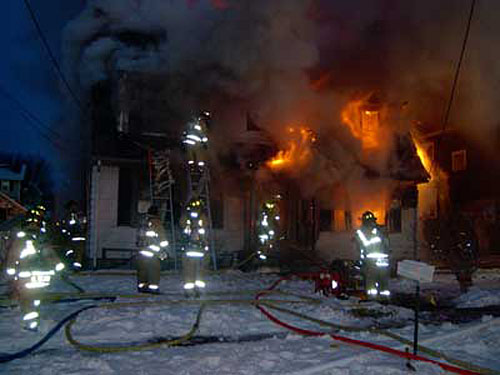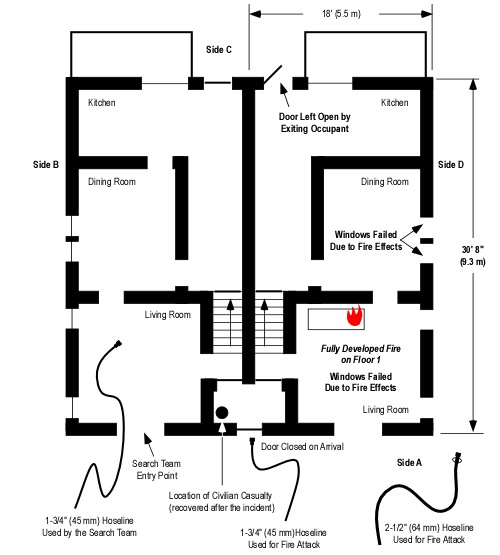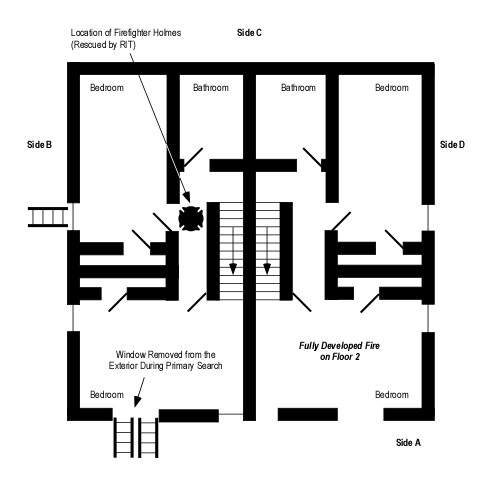Developing & Using Case Studies
Pennsylvania Duplex Fire LODD
Developing & Case Studies
The National Institute for Occupational Safety and Health (NIOSH) recently released Death in the Line of Duty Report F2008-06 on an incident that occurred in February 2008 in Grove City, Pennsylvania. As I read through the narrative and recommendations I began to ask myself how other firefighters and fire officers might use these reports and how much time they would spend engaged with a particular case. Talking with a number of colleagues, we came to the conclusion that many people would read the summary and recommendations and quickly skim through the detailed information to get a sense of what happened. A smaller number of firefighters and fire officers would really dig into the report to identify lessons learned that go beyond or differ from the NIOSH recommendations.
Developing, teaching, and learning using case studies can be an effective element in deliberate practice (see Outstanding Performance). However, as published NIOSH Death in the Line of Duty reports are not necessarily effective case studies. In most cases, reports involving traumatic fatalities need additional clarification or detail and recommendations may need to be removed or at least separated from the description of the incident. When using a case study, it is essential to have the learners make sense of what happened and develop their own conclusions. However, it is often useful to follow this process with a detailed examination of the NIOSH recommendations to determine points of agreement and disagreement and engage in discussion of why.
I have started developing a case study using NIOSH Report F2008-06. Over the last two weeks, I have invested roughly 35 hours in this process (not completely finished). Development has included producing a comprehensive timeline based on data provided in the report as well as from other sources, a narrative designed to assist learners in drawing key lessons from the case, and developing supporting graphics.
This case study will serve as a foundation for a series of posts over the next few weeks. The case will be presented in the following segments: Initial response and size-up, tactical operations, extreme fire behavior and firefighter rescue, water supply, and analysis of NIOSH recommendations.
The Case
On February 29, 2008 Firefighter Brad Holmes and Lieutenant Scott King were assigned to perform primary search of Exposure Delta at a fire in a wood frame duplex in Grove City, PA. During their search, rapidly deteriorating conditions trapped the search crew. After being rescued by the Rapid Intervention Team, both members were transported to Pittsburgh’s Mercy Hospital Burn Unit. Firefighter Brad Holmes had burns over 75% of his body, and died from his injuries on March 5, 2008. Lieutenant King suffered less serious injuries and was treated and released. A 41 year old female occupant of the dwelling also died attempting to rescue a pet.
Figure 1. 132 Garden Avenue-Side Alpha
Note: Fire Department Photo – NIOSH Death in the Line of Duty Report F2008-6. This photo likely illustrates conditions after 0635 (approximately 19 minutes after arrival of the first fire unit, Chief 95).
Building Information
The fire originated in the D Side unit of a two-story, wood frame duplex at 132 Garden Avenue in Grove City, Pennsylvania. The building was originally built in the 1930s and remodeled into two separate dwelling units in the 1960s.
Figure 2. Fire Unit and Exposure Bravo Floor 1
Note: This floor plan is based on data provided in NIOSH Report F2008-06 and is not drawn to scale. Windows shown as open are based on the narrative or photographic evidence. Door position is as shown based on information provided by NIOSH Investigator Steve Berardinelli (this differs from the NIOSH report which includes the fire investigators rough sketch showing all doors open). Windows shown as intact are not visible in the available photographs, but may be open due to fire effects or firefighting operations (particularly those in the fire unit).
Figure 3. Fire Unit and Exposure Bravo Floor 2
Note: See the prior comments regarding windows and door position.
As illustrated in Figures 2 and 3, the floor plan of each unit was a mirror image of the other. The first floor had a living room, dining room and kitchen and a deck on Side C. The units shared a common entry on Side A. The second floors had two bedrooms and a bathroom.
The 36′ x 30′ structure was of balloon-frame construction and had a basement. Interior construction was plaster over wood lath with carpeting over hardwood floors. The unit on Side D (fire unit) had wood paneling throughout the first floor. Exterior construction was wood clapboards over wooden framing. The building was not insulated and did not contain a rated fire wall between the units. The roof covering was asphalt shingles over an undetermined type of wood sheathing.
Dispatch Information
The initial call reporting this incident was 0606 hours, but was disconnected prior to communication of the nature of the emergency. A law enforcement unit was initially dispatched to the address to investigate the interrupted call. A second call was received from an occupant of the fire unit (Side D) at 0609 reporting the fire and that his wife was trapped.
Station 95 (Chief 95, Accountability Officer (POV), Engine 95, Engine 85-2, Squad 95) and Ambulance 100 were dispatched at 0609 followed by Stations 85 (Engine 85, Engine 85-2, Squad 85) and 87 (Rescue 87) at 0611.
The law enforcement officer initially dispatched to the disconnected call arrived at 0612 and reported a working fire with entrapment. Based on this report, the Station 95 Assistant Chief (unit not specified) requested an additional engine prior to arrival. Station 77 (Engine 77, Brush 77, and Water Tender 77) was dispatched at 0614.
Weather Conditions
The temperature was 6o F (-14o C) with no wind.
Conditions on Arrival
Chief 95 arrived at 0616 and established Command. Fire was showing from the first floor unit on Side D extension and there was significant involvement of Floor 2 of the same unit. The IC did a quick 360o size-up and determined the structure was a duplex by the two separate decks at the rear of the structure. However, this information was not communicated to the responding companies. The IC spoke to law enforcement and confirmed that there was an occupant trapped, but received no information about the occupant’s last known location.
Questions
The following questions provide a basis for examining the first segment of this case study. While limited information is provided in the case, this is similar to an actual incident in that you seldom have all of the information you want.
- What stage(s) of fire and burning regime do you believe existed in the involved unit when Chief 95 arrived? (Remember that Figure 1 illustrates conditions considerably later in the incident than Chief 95’s arrival.)
- What building factors are likely to influence fire development and extension?
- What information should Command communicate to responding companies based on his size-up and assessment of the situation?
- Chief 95 was on-scene for four minutes prior to the arrival of the first arriving engine company. If you were Chief 95, what actions would you take during this time (and why)?
What impact might weather conditions have on firefighting operations?
Ed Hartin, MS, EFO, MIFireE, CFO
Tags: case study, Extreme Fire Behavior, flashover, NIOSH






June 27th, 2009 at 05:57
Andrews, News reports indicated that Ms. Smith’s age was either 40 or 44 and the NIOSH report indicated that she was 44. As the age of the victim did not impact on the causal or contributing factors related to the fire behavior in this incident and subsequent firefighter fatality, I simply went with the age cited in the NIOSH report. Ed
June 27th, 2009 at 07:53
Regardless of the impact of the victim’s age on the fire behavior, out of respect for her family who have commented on this fact, if possible, it would be nice for you to change the victim’s age to the appropriate year.
June 28th, 2009 at 15:06
Please accept my apology, I have corrected her age.